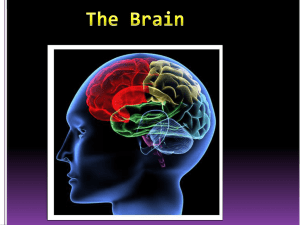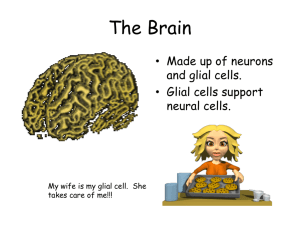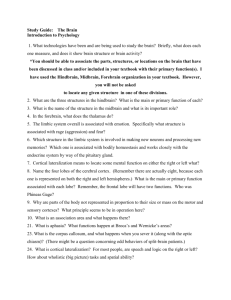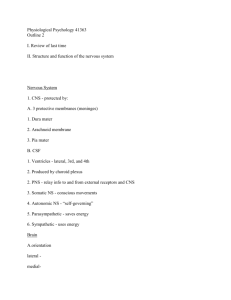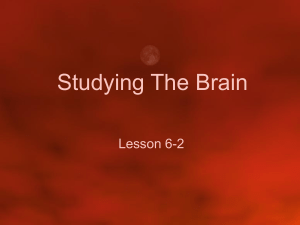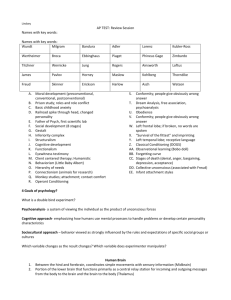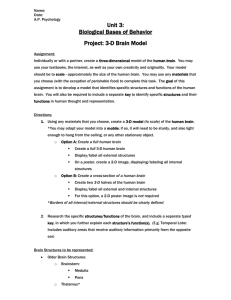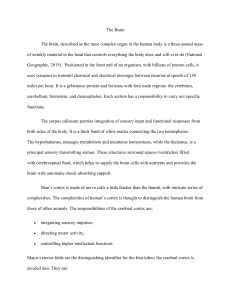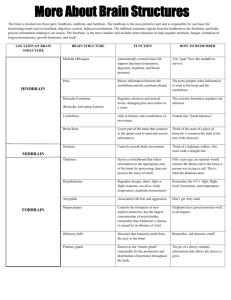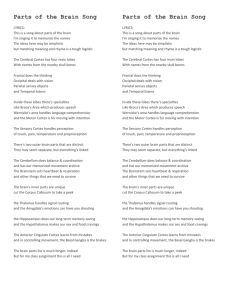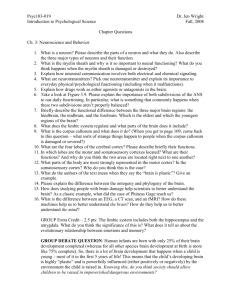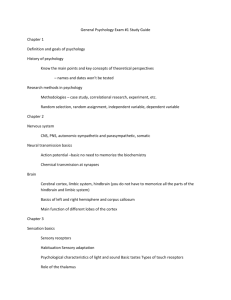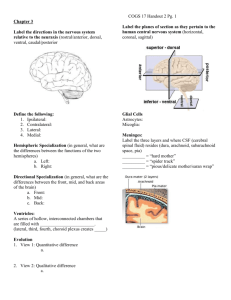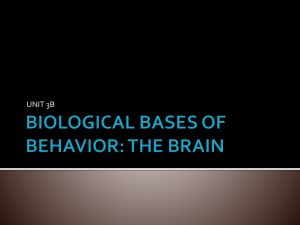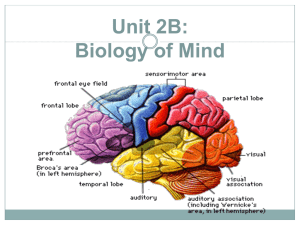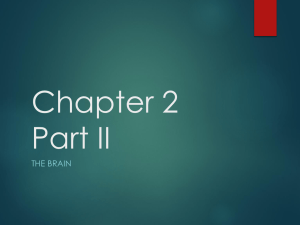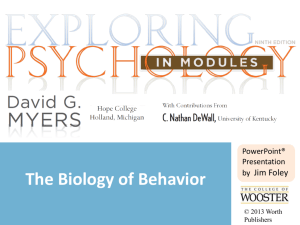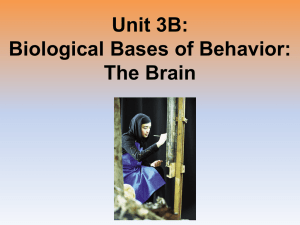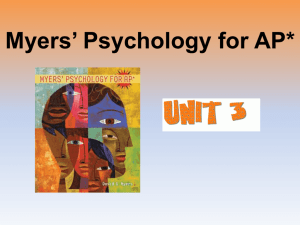Brain - AP Psychology Community
advertisement
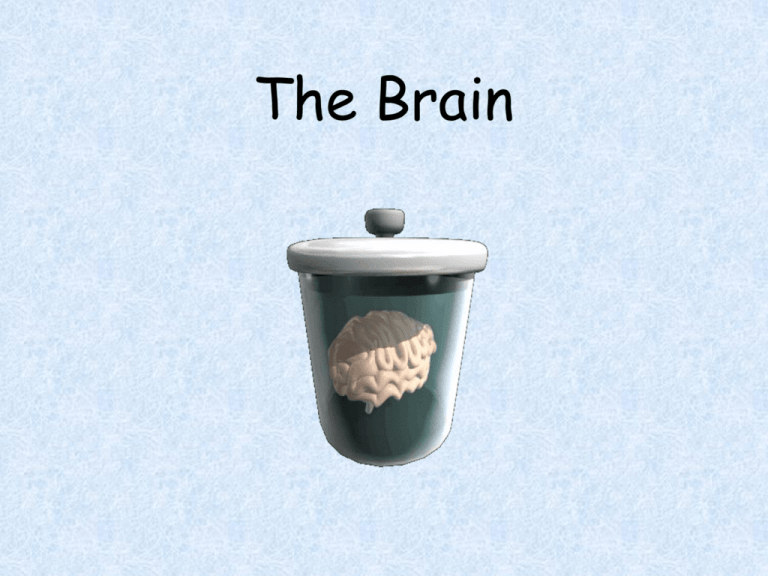
The Brain Ways we Study the Brain • • • • • • Accidents Lesions CAT Scan PET Scan MRI Functional MRI Accidents Phineas Gage Story • Personality changed after the accident. What this this tell us? • That different part of the brain control different aspects of who we are. Lesions • Removal or destruction of some part of the brain. • Frontal Lobotomy Electroencephalogram • EEG • Detects brain waves through their electrical output. • Used mainly in sleep research. Computerized Axial Tomography • CAT Scan • 3D X-Ray of the brain. • Good for tumor locating, but tells us nothing about function. Magnetic Resonance Imaging • MRI • More detailed picture of brain using magnetic field to knock electrons off axis. • Takes many still pictures and turns images into a movie like production. Positron Emission Tomography • PET Scan • Measures how much of a chemical the brain is using (usually glucose consumption). Functional MRI • Combination of PET and MRI Brain Structures 1. Hindbrain 2. Midbrain 3. Forebrain 4. Cerebral Cortex (part or forebrain) Hindbrain • Structures on top of our spinal cord. • Controls basic biological structures. The brain in purple makes up the hindbrain. Medulla Oblongata • Located just above the spinal cord. Involved in control of • blood pressure • heart rate • breathing. Pons • Located just above the medulla. • Connects hindbrain with midbrain and forebrain. • Involved in facial expressions. Cerebellum • Bottom rear of the brain. • Means “little brain” • Coordinates fine muscle movements. Cerebellum Midbrain • Coordinates simple movements with sensory information. • Most important structure in Midbrain is the Reticular Formation: controls arousal and ability to focus our If Destroyed attention. If stimulated Forebrain • What makes us human. • Largest part of the brain. • Made up of the Thalamus, Limbic System and Cerebral Cortex. Thalamus • Switchboard of the brain. • Receives sensory signals from the spinal cord and sends them to other parts of the forebrain. • Every sense except smell. The Limbic System Hypothalamus • Maybe most important structure in the brain. Controls and regulates • Body temperature • Sexual Arousal • Hunger The most powerful • Thirst structure in the brain. • Endocrine System Rat with an Implanted Electrode in pleasure center of Hypothalamus Hippocampus • Involved in the processing and storage of memories. Amygdala • Involved in how we process memory. • More involved in volatile emotions like The emotion of anger has anger. not changed much throughout evolution. The Cerebral Cortex • Made up of densely packed neurons we call “gray matter” • Glial Cells: support brain cells. • Wrinkles are called fissures. • If you lay brain out it would be as big as a large Pizza 2000 pizza. Hemispheres Divided into to hemispheres. • Contralateral control: right controls left and vice versa. In general, Left Hemisphere: logic and sequential tasks. Right Hemisphere: spatial and creative tasks. The Cerebral Cortex is made up of four Lobes. Frontal Lobes • Abstract thought and emotional control. • Contains Motor Cortex: sends signals to our body controlling muscle movements. • Contains Broca’s Area: responsible for controlling muscles that produce speech. • Damage to Broca’s Area is called Broca’s Aphasia: unable to make movements to talk. Motor and Sensory Cortexes Parietal Lobes Where would this girl feel the most pain from her sunburn? • Contain Sensory Cortex: receives incoming touch sensations from rest of the body. • Most of the Parietal Lobes are made up of Association Areas. Association Areas • Any area not associated with receiving sensory information or coordinating muscle movements. Motor and Sensory Cortexes Occipital Lobes • Deals with vision. • Contains Visual Cortex: interprets messages from our eyes into images we can understand. Temporal Lobes • Process sound sensed by our ears. • Interpreted in Auditory Cortex. • NOT LATERALIZED. • Contains Wernike's Area: interprets written and spoken speech. • Wernike's Aphasia: unable to understand language: the syntax and grammar jumbled. Specialization and Integration in Language Brain Activity when Hearing, Seeing, and Speaking Words Brain Plasticity • The idea that the brain, when damaged, will attempt to find news ways to reroute messages. • Children’s brains are more plastic than adults. The Corpus Callosum Divides the 2 hemispheres. Split Brain Patients Those who dues to epilepsy, have their corpus callosum removed. Testing the Divided Brain Decreasing Left-handers
